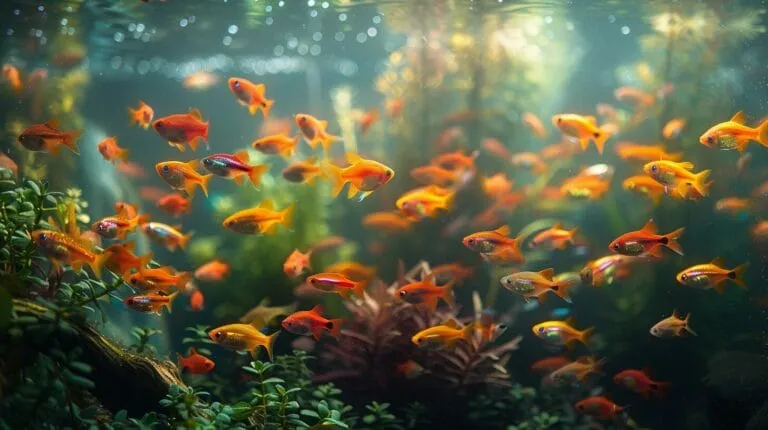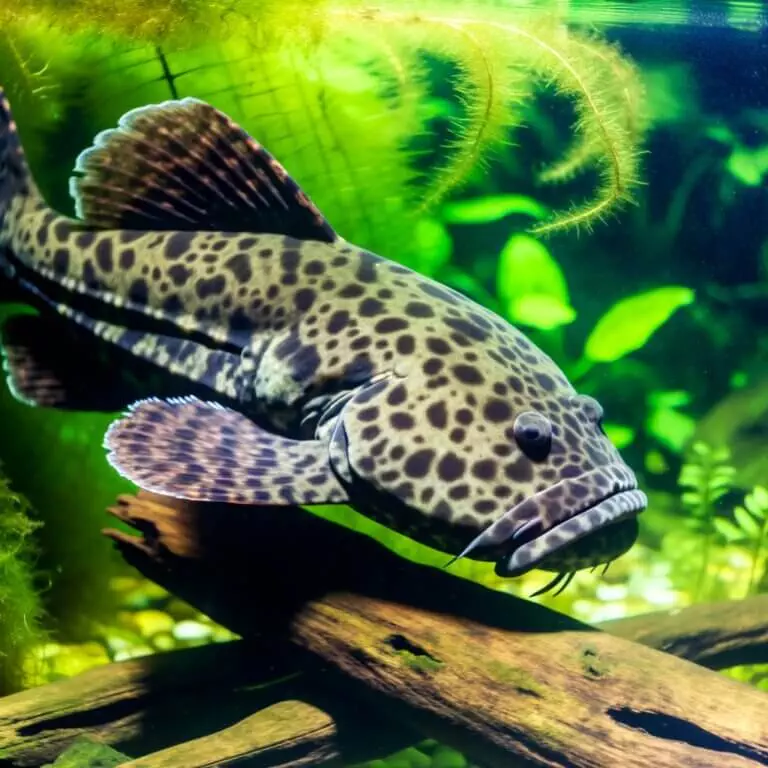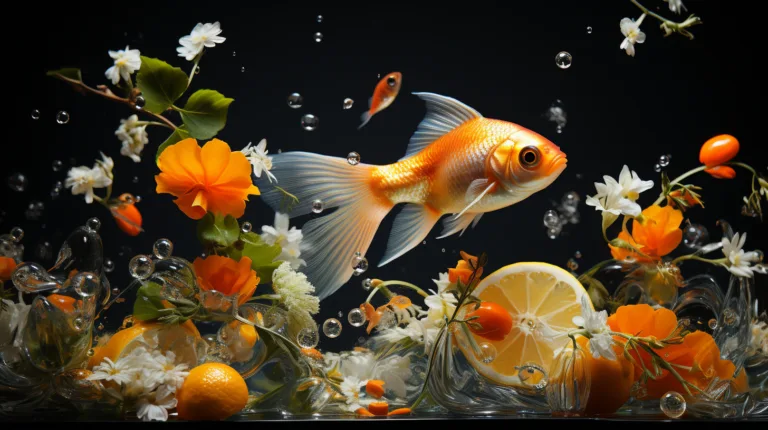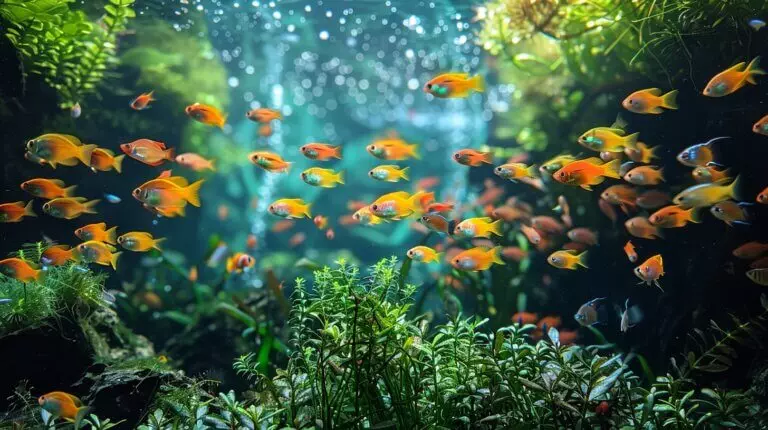Clown fish diet is more complex than you might think. These vibrant orange fish need a balanced mix of foods to thrive in both wild and aquarium settings. You’ll be surprised to learn that clownfish are actually omnivores, eating both plant and animal matter. 1 This means they require a varied diet to stay healthy and maintain their stunning colors.
As an experienced aquarist, I’ve spent years perfecting clownfish care. I’ve discovered that feeding your clownfish the right foods in the right amounts is key to their well-being.
In this guide, you’ll learn exactly what to feed your clownfish, how often, and why. Get ready to become a clownfish feeding expert!
Key Takeaways
- Clownfish eat both plants and animals in the wild and aquariums.
- Feed adult clownfish twice daily with small portions for 1 to 2 minutes.
- Offer a mix of marine pellets, frozen foods, and live treats like brine shrimp.
- Baby clownfish need special tiny foods at first, then slowly move to adult food.
- A good diet helps keep clownfish healthy and makes their colors bright.
Understanding the Clown Fish Diet in Natural Habitats

Clownfish eat a varied diet in the wild. Their menu includes small crustaceans, algae, and bits of food from their host anemones.
What Clownfish Eat in the Wild
Clownfish munch on a variety of foods in the wild. Their main diet consists of zooplankton, tiny shrimp, and fish eggs. These little swimmers also nibble on algae and leftover bits from their sea anemone homes. Plankton forms a big part of their meals, drifting by in ocean currents. 1
Clownfish are nature’s opportunistic eaters, making the most of their coral reef buffet.
You’ll find these orange fish snacking on copepods and larvae too. They’re not picky! Sea anemones provide extra treats. Clownfish eat undigested prey and trapped algae from their tentacled partners. This mix keeps wild clownfish healthy and happy in warm waters.
The Role of Anemones in Clownfish Feeding Habits
Anemones play a key role in clownfish feeding habits. These sea creatures offer a safe home and food source for their fishy friends. 3 The tentacles of anemones catch small prey and food particles from the water.
This creates a buffet for clownfish, who snack on these leftovers. You’ll often see clownfish darting in and out of anemone tentacles, grabbing bits of food.
Your clownfish and anemone have a give-and-take relationship. The fish help feed their host too. They lure other fish close to the anemone’s stinging cells. Once zapped, these unlucky visitors become meals for both the anemone and clownfish. 2 The fish’s waste also feeds the anemone. This teamwork ensures both creatures stay well-fed in their coral reef home.
Seasonal Variations in Clownfish Diet
Clownfish diets change with the seasons. In warmer months, more zooplankton float in the water. This gives clownfish extra food choices. They eat more tiny shrimp and fish eggs during this time.
When it’s cooler, fewer small creatures swim around. Clownfish then rely more on algae and leftover bits from their anemone homes. 4
Food availability affects clownfish health and breeding. Spring and summer bring food booms. This helps clownfish grow and make babies. Fall and winter mean less food. Clownfish must adapt their eating habits.
You can mimic these natural cycles in your tank. Offer varied foods year-round to keep your clownfish healthy and happy. Next, let’s look at some expert tips for feeding clownfish in home tanks. 2
Clown Fish Diet in Aquarium Life: Essential Food Items

Feeding your clownfish in an aquarium is easy. You’ll need to know what foods to give and how often to feed them.
Recommended Commercial Foods for Clownfish
Commercial foods for clownfish come in various forms. Marine pellets or flakes serve as a staple diet. These products contain essential nutrients for your clownfish’s health. Choose high-quality brands that offer balanced nutrition. 4
Thawed frozen foods add variety to your clownfish’s meals. Mysis shrimp, cyclops, brine shrimp, and krill are excellent options. These foods mimic the natural diet of clownfish in the wild.
Vitamin-soaked freeze-dried foods also provide extra nutrients. Offer these foods 2 to 3 times a week to supplement your clownfish’s diet. 3
Live and Frozen Food Options for Aquarium Clownfish
Clownfish thrive on a varied diet in aquariums. You can offer them live and frozen foods to mimic their natural eating habits. 3 Clownfish also enjoy high-quality pellet and flake foods as a staple in their diet, ensuring they receive proper nutrition. Just like the African dwarf frog diet requires variety to promote health, clownfish benefit greatly from incorporating different types of food into their meals. By providing a balanced and diverse feeding routine, aquarists can help maintain the vibrant colors and overall well-being of their clownfish.
- Live brine shrimp: A favorite snack rich in protein and easy to culture at home.
- Frozen mysis shrimp: Packed with nutrients and closely resembles their wild prey.
- Bloodworms: High in iron and protein, great for boosting clownfish health.
- Frozen krill: Excellent source of omega-3 fatty acids for vibrant colors.
- Daphnia: Tiny crustaceans that aid in digestion and promote growth.
- Frozen fish eggs: Mimic natural food sources and boost breeding behavior.
- Live copepods: Tiny organisms that clean tanks and provide a natural food source.
- Frozen squid pieces: Rich in protein and help maintain muscle mass.
- Spirulina flakes: Plant-based option for added vitamins and minerals.
- Frozen brine shrimp: Easy to portion and store for regular feeding.
How Often and How Much to Feed Aquarium Clownfish
Now that you know about live and frozen food options, let’s talk about feeding schedules. Proper timing and portions are key to keeping your clownfish healthy and happy.
- Feed adult clownfish twice daily
- Offer food in the morning and eveningSpace feedings about 12 hours apartStick to a regular schedule.
- Feed juveniles 3 to 4 times per day
- Young clownfish need more frequent mealsSpace feedings 4 to 6 hours apartAdjust as they grow into adults
- Limit feeding time to 1 to 2 minutes
- Watch your fish eat for this short periodRemove uneaten food after 2 minutesPrevents overfeeding and water pollution
- Offer small portions
- Give only what they can eat in 1 to 2 minutesStart with a tiny pinch and adjust as neededBetter to underfeed slightly than overfeed
- Use the eyeball method for portion size
- Feed an amount about the size of the fish’s eye
- This works for most adult clownfish
- Adjust based on your fish’s appetite and size
- Thaw frozen foods before feeding
- Place frozen cube in a cup of tank water
- Let it thaw for a few minutes
- Never use hot water or microwaves to thaw
- Vary the diet for balanced nutrition
- Rotate between flakes, pellets, and frozen foods
- Include both plant and animal-based options
- This mimics their natural diet in the wild.
- Watch for signs of overfeeding
- Bloated stomachs
- Leftover food in the tank
- Cloudy water or algae growth
- Adjust feeding during breeding
- Increase food slightly for breeding pairs
- Offer more protein-rich options
- Return to normal feeding after spawning
Nutritional Needs of Baby Clownfish: A Special Diet

Baby clownfish need special food to grow strong. They start with tiny meals and move up to bigger ones as they age. Want to know more about feeding baby clownfish? Keep reading!
Feeding Requirements for Clownfish Fry
Clownfish fry need special care in their early days. You must feed them the right food to help them grow strong and healthy.
- Start with rotifers: These tiny creatures are perfect for newborn fry. Feed them 3 to 4 times a day.
- Move to fine fry foods: As they grow, switch to finer foods. This happens around day 5-7.
- Introduce crushed pellets: At 2-3 weeks old, mix in some crushed pellets. This helps them get used to adult food.
- Feed daily: Offer food at least once a day, even for older fry. This keeps them well-fed and growing.
- Use small portions: Give only what they can eat in 2 to 3 minutes. Too much food can dirty the water.
- Try live foods: Brine shrimp or copepods are great choices. These boost growth and color.
- Add variety: Mix different foods to ensure a balanced diet. This helps prevent deficiencies.
- Watch for leftovers: Remove uneaten food after 5 minutes. This keeps the tank clean.
Transitioning Baby Clownfish to Adult Diet
Baby clownfish need special care as they grow. You’ll start them on tiny foods like rotifers. As they get bigger, move to crushed flakes or small pellets. Watch how they eat and look at their bellies.
A plump belly means they’re eating well. Don’t rush the change. Take it slow over a few weeks. Mix new and old foods at first. This helps their tummies adjust. 4
Your new clownfish might not eat right away. Don’t worry! Give them time to settle in. Offer small amounts of food 3 times a day. Remove any leftovers after 5 minutes. Try different foods to see what they like best.
Frozen brine shrimp or mysis shrimp are good choices. As they grow, increase food size but not amount. Keep portions small to avoid overfeeding.
Common Mistakes in Feeding Young Clownfish
Feeding young clownfish requires care and attention. Many hobbyists make errors that can harm their fish’s health.
- Overfeeding: Giving too much food leads to water quality issues. Use the “eyeball method” for portion control. 4
- Wrong food size: Offer food that fits the fish’s mouth. Large pellets can choke baby clownfish.
- Ignoring nutritional needs: Young clownfish need specific diets. Start with rotifers, then move to larger foods as they grow.
- Skipping live foods: Live foods like brine shrimp are vital for growth. Include them in the diet.
- Inconsistent feeding times: Set a regular schedule. Feed small amounts 3 times a day. 5
- Poor food variety: Mix flakes, pellets, and frozen foods for balanced nutrition.
- Neglecting water quality: Remove uneaten food after 5 minutes to prevent ammonia spikes.
- Using adult fish food: Baby clownfish can’t digest adult food well. Choose foods made for fry.
- Forgetting supplements: Add vitamins to boost health and color.
- Rushing diet changes: Slowly introduce new foods over time. Quick changes can upset digestion.
The Impact of Diet on Clownfish Health and Coloration

A clownfish’s diet shapes its health and colors. Good food keeps them bright and strong.
Importance of a Balanced Diet for Clownfish
Clownfish need a mix of plant and animal foods to stay healthy. You must give them a varied diet in your tank. This includes tiny sea creatures, special fish pellets, and frozen foods.
Live foods like brine shrimp are also great for them. Don’t forget to add vitamin-soaked freeze-dried food to fill any gaps in their diet.
A good diet keeps your clownfish bright and active. It helps their colors pop and boosts their immune system. Your clownfish will thrive with the right balance of nutrients in their meals.
How Diet Affects Clownfish Coloration
Your clownfish’s diet plays a big role in its color. Carotenoids in food help make reds, oranges, yellows, and blues pop. Many fish keepers say feeding certain foods makes colors brighter.
But science hasn’t proven this yet. Still, a good diet keeps fish healthy and looking their best. Giving varied, high-quality foods helps maintain vivid hues.
Addressing Nutritional Deficiencies in Clownfish
Clownfish need a balanced diet to stay healthy. Feed them high-quality marine pellets and vitamin-soaked foods daily. Look for signs of nutritional issues like a sunken belly or dull colors.
If you spot these, adjust their diet right away. Add variety with frozen foods and algae tabs. This mix helps prevent deficiencies and keeps your clownfish vibrant.
Monitor your clownfish closely during feeding time. A plump belly shows they’re eating well. If they seem thin or refuse food, check your water quality first. Poor water can affect appetite.
Then, try different food types to find what they like best. Some clownfish prefer smaller pellets or flakes. Others may go for frozen brine shrimp or mysis shrimp. Always soak dry foods in tank water before feeding to avoid digestive issues.
Expert Tips for Optimizing Clown Fish Diet in Captivity
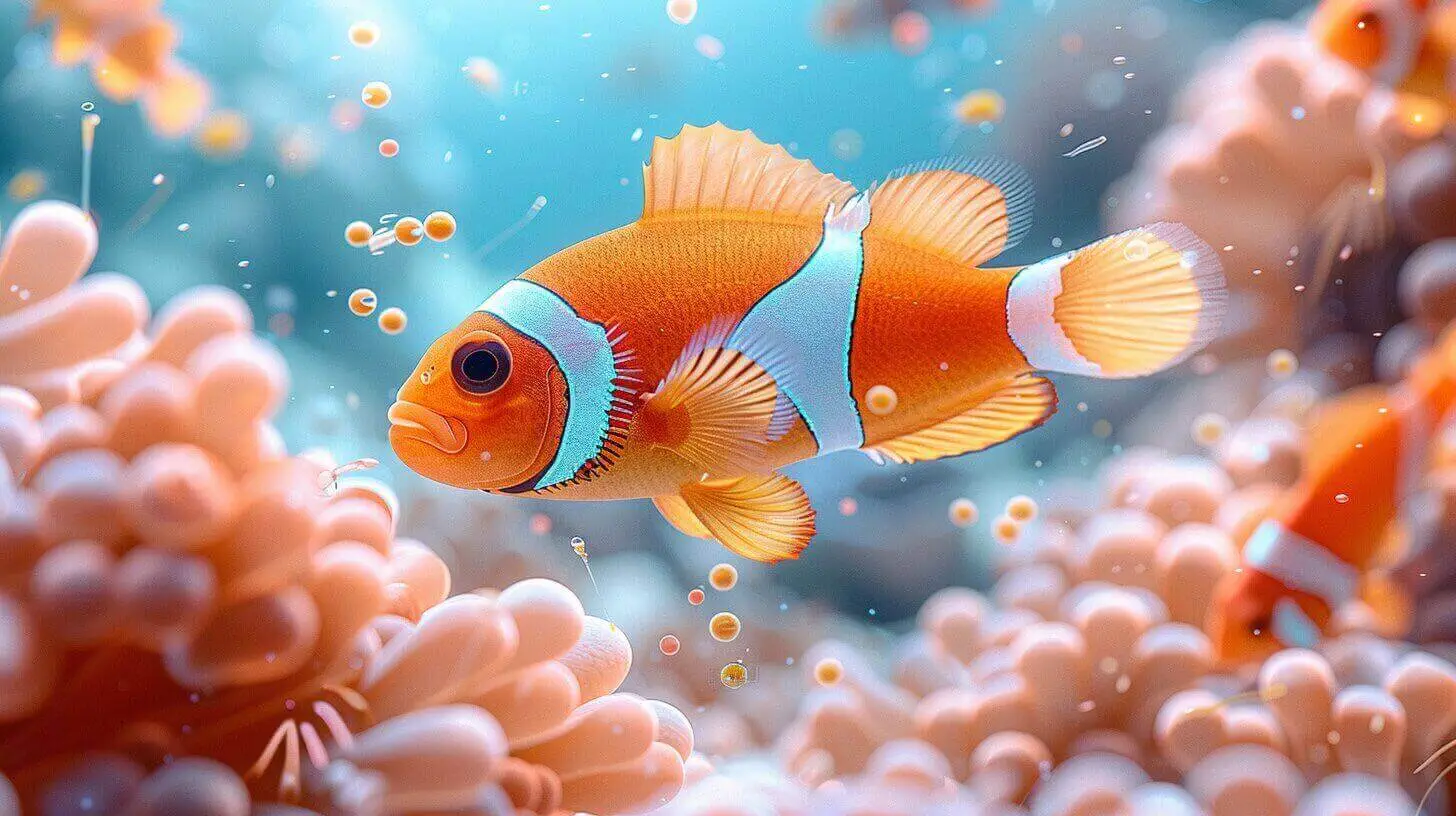
Want to keep your clownfish happy and healthy? These expert tips will help you create the perfect diet for your aquarium friends. Learn how to mimic their natural eating habits and boost their health with the right food choices.
Replicating Natural Feeding Patterns in Aquariums
Clownfish thrive on varied diets in the wild. You can mimic these natural feeding patterns in your aquarium for healthier fish.
- Offer a mix of foods: Use pellets, flakes, frozen, and live options daily 4
- Set a feeding schedule: Feed small amounts 2 to 3 times per day 1
- Vary feeding spots: Drop food in different areas to encourage foraging
- Use slow-release feeders: Mimic grazing with automatic feeders or clip-on algae sheets
- Include plant matter: Give seaweed or spirulina for plant nutrients
- Provide live foods: Offer brine shrimp or copepods weekly as treats
- Match pellet size to fish size: Use smaller bits for juveniles, larger for adults
- Limit portions: Feed only what fish eat in 2 to 3 minutes to avoid waste
- Create water movement: Use powerheads to simulate currents during feeding
Supplementing Clownfish Diet for Optimal Health
Proper diet supplements boost clownfish health. You can enhance your clownfish’s diet with these key items:
- Marine pellets: Feed PE Mysis and TDO Chroma Boost. These pellets pack vital nutrients for your fish.
- Brine shrimp: Offer live or frozen brine shrimp. They’re a great protein source and help fish try new foods.
- Algae tabs: Give an algae tab now and then. This mimics the plant matter clownfish eat in the wild.
- Seaweed sheets: Clip small pieces to the tank. Your clownfish will nibble on these throughout the day.
- Varied diet: Mix up food types. This ensures your fish gets all needed nutrients.
- Vitamin drops: Add to food once a week. They fill any gaps in your fish’s diet.
- Garlic guard: Soak food in this before feeding. It boosts the immune system and appetite.
- Omega-3 supplements: Sprinkle on food twice a week. These fats support brain and eye health.
- Color-enhancing foods: Use foods with natural color boosters. They keep your clownfish bright and vibrant.
- Small, frequent meals: Feed 2-3 times daily. This matches their natural eating habits.
Adapting Diet for Different Clownfish Species
Feeding your clownfish the right food is important for keeping them healthy. Let’s talk about what different clownfish like to eat.
Clownfish species have unique dietary needs. Ocellaris clownfish thrive on a mix of marine flakes and frozen foods. 4 Maroon clownfish need more protein-rich diets. Feed them small chunks of shrimp or fish.
Tomato clownfish enjoy a varied diet of pellets and live foods. 3 Adjust portion sizes based on the fish’s size. Smaller species eat less than larger ones. Offer food 2 to 3 times daily for most species. Watch your fish eat to ensure they’re getting enough.
Conclusion
Clownfish thrive on varied diets in both wild and captive settings. You can keep your clownfish healthy with a mix of marine pellets, frozen foods, and live treats. Feed adult clownfish once daily, and juveniles two to three times a day.
Match food quantity to the size of your fish’s eye. With proper care, your clownfish will display vibrant colors and active behavior in your aquarium.
FAQs
1. What do clownfish eat in the wild?
Clownfish are omnivores. They eat tiny bits from the water… and sometimes munch on algae. In the ocean, they snack on small crustaceans and plankton. They also get food from their anemone friends.
2. How often should I feed my clownfish in a tank?
Feed your clownfish 2-3 times a day. Give them only what they can eat in 2-3 minutes. Don’t overfeed! Extra food can make the water dirty.
3. What’s the best food for pet clownfish?
Mix it up! Use quality flakes, small pellets, and frozen foods. Treats like brine shrimp are good too. An algae tab now and then is nice. Match their natural diet as best you can.
4. Do clownfish eat anemones?
No, they don’t eat anemones. They have a special friendship. The anemone gives the clownfish a safe home. In return, the clownfish brings food to the anemone.
5. Can baby clownfish eat the same food as adults?
Baby clownfish need smaller food. Try crushed flakes or special baby fish food. As they grow, you can give them bigger bits. Always match the food size to the fish size.
6. Do clownfish in tanks need live food?
Live food isn’t a must, but it’s a nice treat. Things like brine shrimp are good. But be careful – live food can bring in bad stuff. Frozen foods are safer and still yummy for your clownfish.
References
- ^ https://www.ouraquariumlife.com/fish/clownfish-food/
- ^ https://www.barrierreef.org/the-reef/animals/clownfish
- ^ https://www.americanoceans.org/uncategorized/what-do-clownfish-eat/
- ^ https://fantaseaaquariums.com/fishes-care/what-does-a-clownfish-eat/ (2021-07-21)
- ^ https://www.petco.com/content/petco/PetcoStore/en_US/pet-services/resource-center/caresheets/clownfish.html (2024-07-17)


